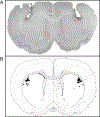Inactivation of the striatum in aged rats rescues their ability to learn a hippocampus-sensitive spatial navigation task
- PMID: 32305514
- PMCID: PMC8915206
- DOI: 10.1016/j.nlm.2020.107231
Inactivation of the striatum in aged rats rescues their ability to learn a hippocampus-sensitive spatial navigation task
Abstract
Studies of age-related changes in learning and memory often focus on hippocampus-sensitive tasks and reveal age-associated impairments across numerous species and contexts. However, cognitive decline with advanced age is not all-encompassing; for example, forms of striatum-sensitive learning are conserved or enhanced with age. Under certain conditions, hippocampal and striatal memory systems function in opposition. In young adult rodents, disruption of one structure can enhance learning on tasks dependent on the other, suggesting that competitive interactions across memory systems contribute to learning and memory abilities. This report examines whether imbalances across memory systems might contribute to cognitive aging. We inactivated the striatum using central infusions of lidocaine (sodium channel blocker) prior to hippocampus-sensitive spatial (place) training in young (3-4-month-old) and old (24-25-month-old) F344 male rats. Consistent with prior work, vehicle-infused old rats exhibited place learning impairments relative to young rats. Additionally, striatal inactivation enhanced learning in old rats, but not young rats, abolishing the age-related impairment. These findings suggest that age-related declines in learning tasks thought to engage the hippocampus may stem from exaggerated interference from other memory systems and that interventions to target the striatum may reverse some age-related learning decrements.
Keywords: Aging; Hippocampus; Lidocaine; Memory modulation; Memory system competition; Spatial learning; Striatum.
Copyright © 2020 Elsevier Inc. All rights reserved.
Conflict of interest statement
Declaration of Competing Interest The authors declare that they have no known competing financial interests or personal relationships that could have appeared to influence the work reported in this paper.
Figures


Similar articles
-
Aging is not equal across memory systems.Neurobiol Learn Mem. 2020 Jul;172:107232. doi: 10.1016/j.nlm.2020.107232. Epub 2020 Apr 18. Neurobiol Learn Mem. 2020. PMID: 32315762 Free PMC article.
-
Contributions of Hippocampus and Striatum to Memory-Guided Behavior Depend on Past Experience.J Neurosci. 2016 Jun 15;36(24):6459-70. doi: 10.1523/JNEUROSCI.0840-16.2016. J Neurosci. 2016. PMID: 27307234 Free PMC article.
-
Age-related impairments in object-place associations are not due to hippocampal dysfunction.Behav Neurosci. 2015 Oct;129(5):599-610. doi: 10.1037/bne0000093. Behav Neurosci. 2015. PMID: 26413723 Free PMC article.
-
Modulation of multiple memory systems: from neurotransmitters to metabolic substrates.Hippocampus. 2013 Nov;23(11):1053-65. doi: 10.1002/hipo.22182. Hippocampus. 2013. PMID: 23929581 Free PMC article. Review.
-
A link between the hippocampal and the striatal memory systems of the brain.An Acad Bras Cienc. 2006 Sep;78(3):515-23. doi: 10.1590/s0001-37652006000300011. An Acad Bras Cienc. 2006. PMID: 16936940 Review.
Cited by
-
Effects of Caloric Restriction on Spatial Object Recognition Memory, Hippocampal Neuron Loss and Neuroinflammation in Aged Rats.Nutrients. 2023 Mar 24;15(7):1572. doi: 10.3390/nu15071572. Nutrients. 2023. PMID: 37049417 Free PMC article.
-
A Neuroeconomics Approach to Obesity.Biol Psychiatry. 2022 May 15;91(10):860-868. doi: 10.1016/j.biopsych.2021.09.019. Epub 2021 Sep 29. Biol Psychiatry. 2022. PMID: 34861975 Free PMC article. Review.
-
Hippocampus-sensitive and striatum-sensitive learning one month after morphine or cocaine exposure in male rats.Pharmacol Biochem Behav. 2022 Jun;217:173392. doi: 10.1016/j.pbb.2022.173392. Epub 2022 May 2. Pharmacol Biochem Behav. 2022. PMID: 35513118 Free PMC article.
-
A novel aged mouse model of recurrent intracerebral hemorrhage in the bilateral striatum.Neural Regen Res. 2023 Feb;18(2):344-349. doi: 10.4103/1673-5374.346459. Neural Regen Res. 2023. PMID: 35900428 Free PMC article.
-
Rodent mnemonic similarity task performance requires the prefrontal cortex.Hippocampus. 2021 Jul;31(7):701-716. doi: 10.1002/hipo.23316. Epub 2021 Feb 19. Hippocampus. 2021. PMID: 33606338 Free PMC article.
References
Publication types
MeSH terms
Substances
Grants and funding
LinkOut - more resources
Full Text Sources

